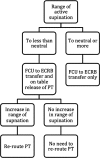Surgery for the Pronated Forearm and Flexed Wrist in Children with Cerebral Palsy
- PMID: 32257022
- PMCID: PMC7093635
- DOI: 10.1007/s43465-019-00021-5
Surgery for the Pronated Forearm and Flexed Wrist in Children with Cerebral Palsy
Abstract
Aim: There is no consensus in the literature on how best to manage wrist flexion and forearm pronation deformities in children with cerebral palsy (CP). The aim of this research was to come up with a treatment algorithm for the surgical management of such cases.
Methods: Children with CP who underwent upper limb surgery between 2009 and 2016 at a single centre and by a single lead surgeon were reviewed retrospectively. Movement analysis and Shriners Hospital Upper Extremity Evaluation (SHUEE) data collected pre- and post-operatively.
Results: Thirteen patients were recruited. Most patients underwent a flexor carpi ulnaris (FCU) to extensor carpi radialis brevis (ECRB) transfer, with or without pronator teres (PT) re-routing, and finger flexor or elbow flexor releases. Mean increase in active range of supination was 40.8° (p = 0.002) and wrist extension 28.9° (p = 0.004). The mean increase in dynamic positional analysis (part of the SHUEE) was 25.4% (of which 40.3% was due the increases in wrist function and 16.8% due to forearm function). The loss of wrist flexion was not significant (p = 0.125). The mean follow-up was 14 months (range 9-21).
Conclusions: To tackle both a pronation and flexion deformity, the authors favour performing a FCU to ECRB transfer in isolation if there is active supination to neutral; if active supination is short of neutral, then a FCU to ECRB with a PT release and possible re-routing performed. A treatment algorithm is proposed.
Level of evidence: IV.
Keywords: Cerebral palsy; ECRB; FCU; Flexion; Movement analysis; Paediatrics; Pronation; Surgery.
© Indian Orthopaedics Association 2020.
Conflict of interest statement
Conflict of InterestThe authors declare that they have no conflict of interest.
Figures
Similar articles
-
The supination effect of tendon transfer of the flexor carpi ulnaris to the extensor carpi radialis brevis or longus: a cadaveric study.J Hand Surg Am. 1999 Sep;24(5):1091-6. doi: 10.1053/jhsu.1999.1091. J Hand Surg Am. 1999. PMID: 10509290
-
Comparison of outcome between operative treatment and constraint-induced movement therapy for forearm and wrist deformities in cerebral palsy. A randomized controlled trial.Hand Surg Rehabil. 2022 Apr;41(2):258-264. doi: 10.1016/j.hansur.2021.12.012. Epub 2022 Feb 3. Hand Surg Rehabil. 2022. PMID: 35124285 Clinical Trial.
-
A prospective study on transfer of pronator teres to extensor carpi radialis brevis for forearm and wrist deformity in children with cerebral palsy.J Hand Surg Eur Vol. 2021 Mar;46(3):247-252. doi: 10.1177/1753193420960330. Epub 2020 Sep 29. J Hand Surg Eur Vol. 2021. PMID: 32990136
-
Cerebral Palsy Tendon Transfers: Flexor Carpi Ulnaris to Extensor Carpi Radialis Brevis and Extensor Pollicis Longus Reroutement.Hand Clin. 2016 Aug;32(3):423-30. doi: 10.1016/j.hcl.2016.03.010. Epub 2016 May 21. Hand Clin. 2016. PMID: 27387086 Review.
-
A PRISMA-IPD systematic review and meta-analysis: does age and follow-up improve active range of motion of the wrist and forearm following pediatric upper extremity cerebral palsy surgery?Front Surg. 2024 Feb 20;11:1150797. doi: 10.3389/fsurg.2024.1150797. eCollection 2024. Front Surg. 2024. PMID: 38444901 Free PMC article. Review.
Cited by
-
Electromyographic biofeedback training in a cerebral palsy patient undergoing pronator teres rerouting and brachioradialis to extensor carpi radialis brevis tendon transfer surgery: A case report.Jt Dis Relat Surg. 2024 Feb 13;35(2):448-454. doi: 10.52312/jdrs.2024.962. Epub 2024 Feb 13. Jt Dis Relat Surg. 2024. PMID: 38727128 Free PMC article.
References
-
- Kreulen M, Smeulders M, Veeger H, Hage J. Movement patterns of the upper extremity and trunk before and after corrective surgery of impaired forearm rotation in patients with cerebral palsy. Developmental Medicine and Child Neurology. 2006;48(6):436–441. doi: 10.1017/S0012162206000958. - DOI - PubMed
LinkOut - more resources
Full Text Sources
Research Materials
Miscellaneous

